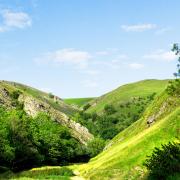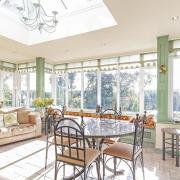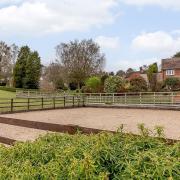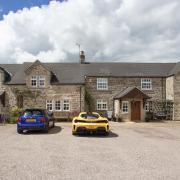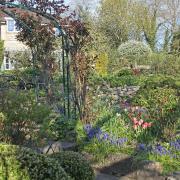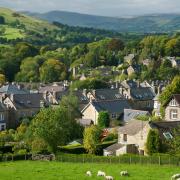As the Hall’s gardens open for a fund-raising garden party, Pat Ashworth has a chance to look round this listed gem near Matlock

ONLY the appearance of six tall, green and beautifully rounded hornbeam trees above a boundary wall gives any hint that you are about to discover something special as you follow the lane that leads to Snitterton Hall. Blink and you could miss the ancient hamlet of Snitterton itself, despite its being just a couple of miles out of Matlock.
The Elizabethan Hall replaced an early moated manor house. John Milward, who fought for the Royalists in the Civil War and was a High Sheriff of Derbyshire under Charles II, bought it in 1631. In the centuries that followed, it became a rather grand farmhouse, which historians suggest may have spared it the extensive re-building that happened at many other grand houses in Derbyshire. Built of stone quarried over the valley at Oker, it is beautifully intact.
Simon Haslam and Kate Alcock discovered it in 2008, and such is the spell that the place casts, they saw it on a Wednesday and bought it on the following Tuesday. The previous owners had done a careful restoration of the Hall, a Grade I listed building described by the art historian and scholar, Nikolaus Pevsner, as ‘a gem of an Elizabethan manor house’. He particularly highlighted the Ionic columns at the front door and the flower motifs on the lintel, all visible today.
There’s a rare chance for visitors to see the gardens on 1st July when the couple are holding a Garden Party to raise funds for Matlock Methodist and United Reformed Church. We get a sneak preview in the company of Ann Ayling, who moved up from Hertfordshire to continue working for Simon and Kate, and Digby, the Dalmatian, whose territory this is and who is keen to show us everything. My recording is punctuated with birdsong, scrunching feet on gravel and our photographer’s efforts to get Digby to pose in some of the garden’s most impressive spots – ‘Sit, Digby… Stay…’ but off he goes, bounding ahead to the next delight.

The first sight for visitors will be the formal garden and parterre in front of the Hall, in all its perfection of symmetry. The garden pavilion here was originally paired by another, in the middle of where the six hornbeams stand, and archaeologists have suggested there might have been a further two on the north side of the Hall. In Elizabethan times, these would have been used for entertaining important guests, with perhaps one course of a meal served in each one before moving on to the next.
Someone had a sense of humour when inscribing the framework of the armillary sphere, or spherical astrolabe, that stands in the centre of the parterre. Horizons, lines of celestial latitude and longitude, compass points and other astronomically important features are all inscribed here as you would expect. But then there’s ‘Cleanliness is next to godliness’… and included among the named distances to places like Lake Como and Venice and the Pole is the rather more surprising Henley-on-Thames.
What will certainly draw the eye here, at the top of a small flight of stone steps, is the sculpture of Lonely the Goat by James Doran-Webb. A quirky, wonderful piece that the couple bought at the RHS Chelsea Flower Show last year, it depicts a goat impossibly teetering on the summit of an apparently loosely balanced column of boulders that must surely collapse.
The official name of the work, made from driftwood that the artist gathers on the shorelines and in the riverbeds and valleys of the Philippines, is The Importance Of Faith When Things Turn A Little Dicey. It’s pleasing to reflect when regarding it, that for every kilo of driftwood that the artist gathers, he plants a seedling on the denuded hills in North and South Cuba. He has started a programme that will see 80,000 trees planted during the next 15 years.
Digby stands on his hind legs to drink from the very aristocratic water butt by the front door before we move on to the square and beautiful lawn and terraces that lie behind the hall, which visitors on 1st July will also be able to explore. Immaculately trimmed yew hedges set off to perfection the flower beds on the lower terrace, where there’s an original belvedere, in this case, a timbered and thatched garden pavilion. A previous owner is said to have been somewhat amused when a workman came to the back door and said, ‘I’ve got to move your shed.’
A brass band will play here on the lower terrace, with plenty of low walls for sitting on. And here are more sculptures to catch the eye, notably The Journey in bronze, by the Welsh artist, Helen Sinclair. The figures depicted on the summit of a rocky pillar are a family group, including a dog, and the most poignant image is of a tiny teddy bear that has fallen from the trailing hand of a child into a crevice in the rocks, and cannot be retrieved. The artist has work in illustrious private collections all over the world.
Barry Sykes’ animal sculptures can be spotted in several locations and all bring a smile to the face. He has used galvanised, weatherproof chicken wire to create the ewe and lamb, the pig and the very amiable alpaca – the latter a present from Simon to Kate in lieu of the real alpaca that she would have liked to see roaming here. There are distinctive Belted Galloway cattle, though, beyond the vegetable garden that flourishes within the walled garden.
That long, encircling garden wall is a story in itself. It was in large part taken down in 2013 – stone by stone, each numbered and bagged to be put back in exactly the same place – when the Haslams put in the architectural marvel that is the subterranean swimming pool. All that is visible on the surface is a glasshouse roof, the site of the original Victorian greenhouse demolished some time before the Second World War. Descent is via a beautiful spiral staircase, on to a surface so white it is like stepping on to snow. You can’t help feeling that if the Elizabethans or even the Victorians had had the technology, they would have done exactly this.
There are long-term plans for the areas that lie outside the formal gardens – the restoration of an old pond, for instance, in a hollow by the tennis court. Water features for now are confined to the stunning reflection pool, ringed with bright tulips, at the back of the house. Meanwhile, family and visitors can enjoy the glories of a garden that is pleasing in every aspect: a joy awaiting discovery.




